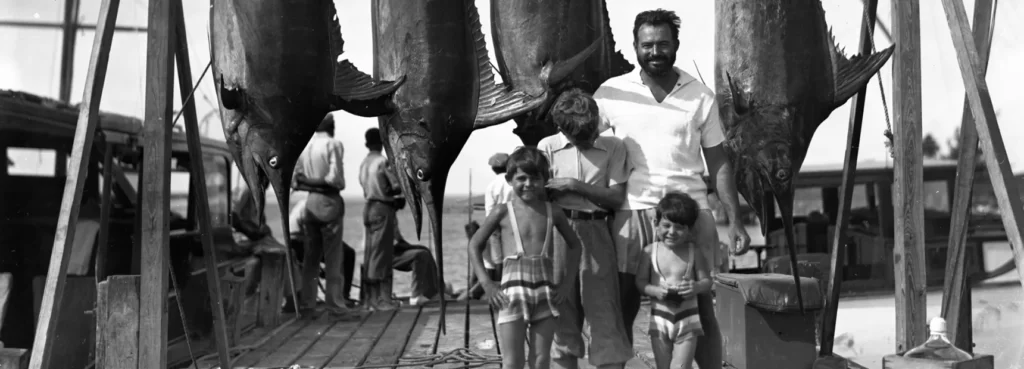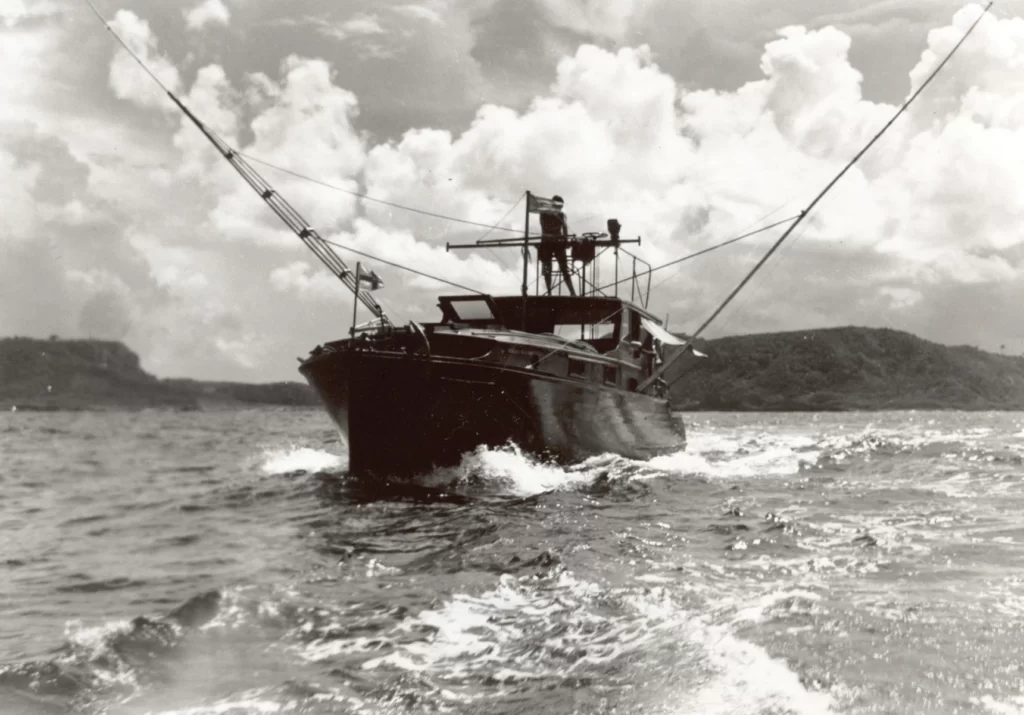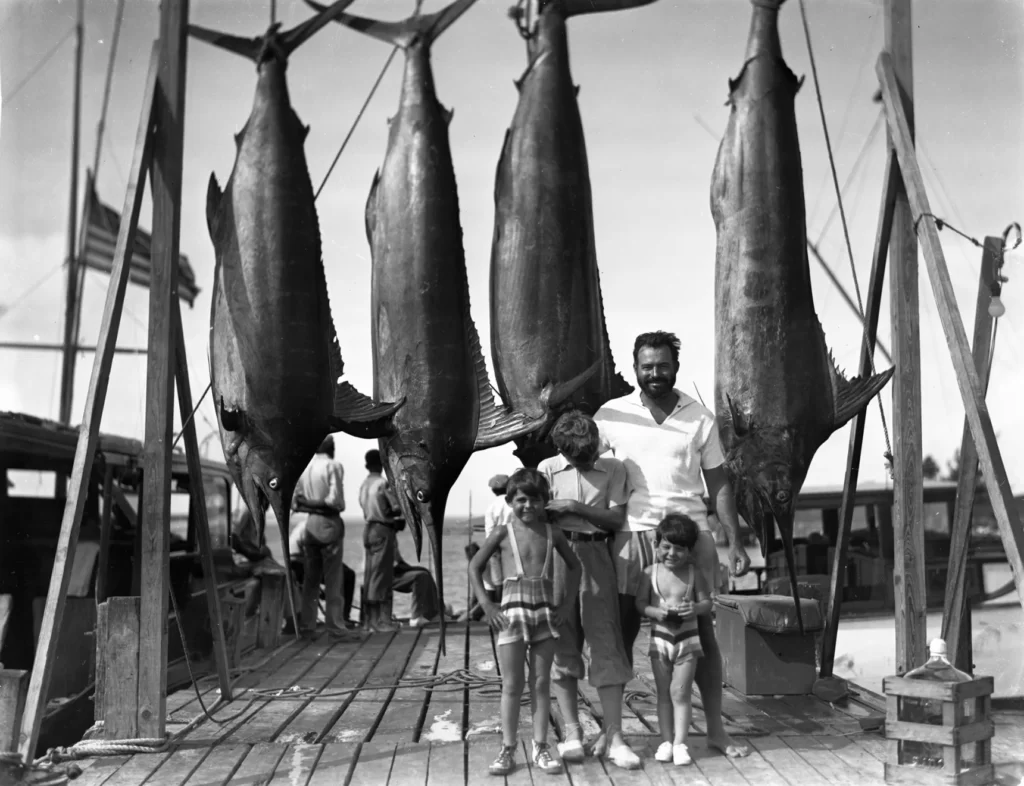
Ernest Hemingway was revered worldwide for his intense literary style and prize-winning novels. In the papers, it was his risky adventures and scandalous personal life that earned him notoriety. But “Papa,” as he liked to be called, contributed more to the 20th century than fiction and headlines … he was also one of the early pioneers of sportfishing boats.
When Hemingway put a deposit down on a 38-foot Playmate he named Pilar from the Wheeler Yacht Company in 1933, he collaborated with Wesley L. Wheeler to modify the wooden boat to better suit his needs. As an avid fisherman and creative genius, Hemingway had lots of ideas for turning the pleasure vessel into a deep-sea fishing machine.
Modifying Pilar
As any fisherman can attest, you need as much patience as you do gear to reel in a big one. Knowing he would want to stay at sea for extended periods of time in pursuit of the ultimate catch, Hemingway requested extra-large fuel and freshwater tanks. These tanks were also helpful in powering the additional 40-horsepower trolling engine Hemingway had installed.
The next modification lowered the transom 12 inches to make it easier to haul in large marlins. Back then, davits were typically used to pull in big fish, but Hemingway took inspiration from the rum runners of the era and installed a roller on the stern to assist with getting heavy sea creatures into his boat. In anticipation of prized catches, Hemingway also added a large icebox.
Pilar Sails the High Seas
In 1934, Pilar’s customizations were complete, and she was shipped to Hemingway’s homebase in Miami, Florida. From there, Hemingway enjoyed taking Pilar on excursions around the Atlantic and often visited Bimini in the Bahamas. The adrenaline of the chase invigorated Hemingway, and he was perpetually thinking of new and innovative ways to enhance his boat.
Outfitting Pilar to be the Ultimate Fishing Vessel
“Every day is a new day. It is better to be lucky. But I would rather be exact. Then when luck comes you are ready.”
~Ernest Hemingway
Having multiple lines while trolling the deep seas is one way to increase your odds of hooking a big fish, but those lines can easily become tangled. To solve this dilemma, Hemingway installed huge outriggers on Pilar. This expanded the width of his trolling spread and he could also troll more baits at one time.

Photo: https://www.anglersjournal.com/saltwater/fighting-big-fish-with-ernest-hemingway
“The father who does not teach his son his duties is equally guilty with the son who neglects them.”
~Ernest Hemingway
While fishing in Bimini, Hemingway wanted a better view of what was biting, but he couldn’t see much from his angle on the deck. So, he put his sons, Jack and Patrick, to work.
Hemingway placed his two boys on the roof of the cockpit. From their elevated position, they could help the crew spot marlins. Not only was this an ingenious solution, it inspired what is believed to be the first-ever flybridge. Hemingway made that vantage point a permanent part of Pilar when he added a raised helm station on the wheelhouse roof. Wanting to get in on the marlin-sighting action while still captaining the boat, he later added handrails plus a steering wheel from a Ford Model T. A system of pulleys and cables enabled Hemingway to run the gears and throttle from the flybridge.
“The secret is for the angler never to rest.”
~Ernest Hemingway
Hemingway eschewed the passive fishing approach and pioneered a more active sporting method. Weighing in at 222 pounds and six feet tall with an athletic physique, Hemingway was a formidable opponent for any large fish he hooked. He used his size to his advantage and created the technique of pumping fish that is used by fishermen today. Once a fish took his bait, Hemingway would raise and lower the rod tip and then reel in the slack, enabling him to use his legs and back instead of just his arms. Even with his novel approach and brute strength, these tiresome battles could wage on for hours.
Luckily, Julio Sanchez was one of Hemingway’s regular fishing buddies in Cuba. Having grown up on the waters and an engineer by trade, a fortuitous incident at a barbershop inspired his most well-known invention. After a haircut, Sanchez was wedged so tightly into the barber’s chair, he couldn’t get out. The barber tugged on his arms to try and pull him out while Sanchez braced his feet firmly on the foot stand. Instead of freeing Sanchez, the barber tumbled across the room. This is when Sanchez realized having a stable base while fighting an external force would be advantageous.
Using his engineering skills, Sanchez built the first fighting chair modeled off the barber’s chair. It swiveled, had a footrest and was bolted into the deck. He also created the first fishing harness, a forebearer of today’s bucket harnesses, to maximize pulling efficiency and support. Sanchez shared these innovations with his pal Hemingway, taking their deep-sea excursions to new heights and earning them countless big game fishing titles.
The ability to fight fish and haul them out of the water faster meant Hemingway didn’t have to resort to shooting sharks that pursued his prize catch. In 1935, Hemingway made history in Bimini for landing the first unmutilated giant tuna on a rod and reel. The next day he caught an even bigger tuna that weighed 381 pounds. These catches made headlines around the globe and set off a sportfishing revolution that copied Hemingway’s techniques.

Photo: https://www.anglersjournal.com/saltwater/fighting-big-fish-with-ernest-hemingway
A Lasting Legacy
In 1998, Ernest Hemingway was posthumously inducted into the International Game Fish Association’s Hall of Fame for his extraordinary achievements in the sport. A few years later in 2001, Julio Sanchez was also bestowed this honor for his contributions to sportfishing techniques and equipment.
“There was nothing easy about big-game fishing in the 1930s. What made Hemingway a better fisherman than anyone else was how hard he worked at it. He was a student of fishing, and to the betterment of us all, he wrote about what he learned in great detail. He taught us to be ‘sport’ fishermen.”
~Tom Greene, owner of Custom Rod and Reel in Lighthouse Point, Florida
